
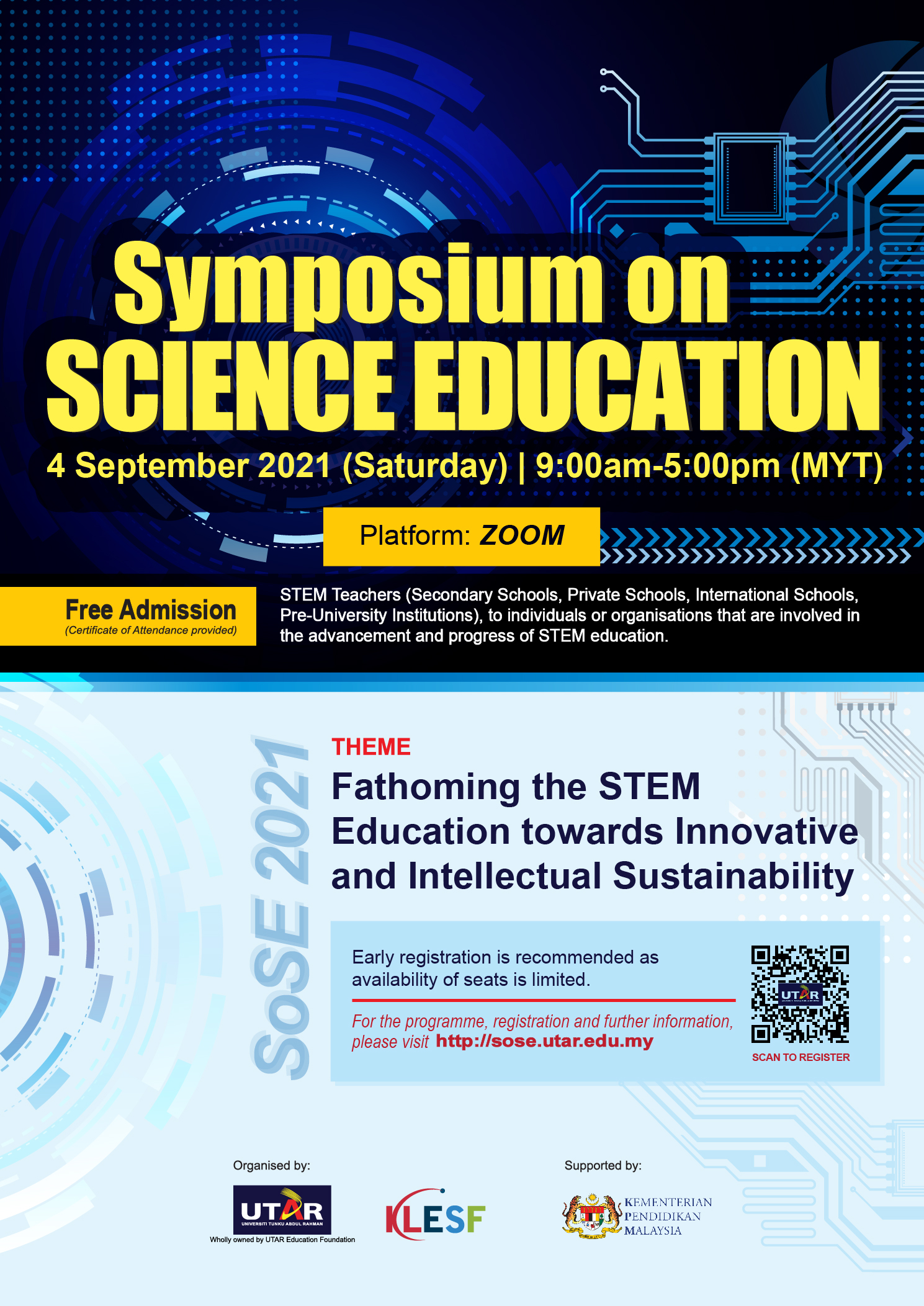
Official poster of SoSE 2021
When great minds gather at the Symposium on Science Education (SoSE) 2021, organised by the Centre for Learning and Teaching (CLT), with the support from the Division of Programme Promotion (DPP), on 4 September 2021 via Zoom, participants gained insights to ideas and techniques for innovative and effective teaching methods for STEM subjects.
Now into its seventh year, SoSE has continuously provided a platform for educators to share innovative and effective teaching methods in STEM education, create awareness of the current innovative teaching methods, and discuss ways to embed innovation in the teaching and learning of STEM education. SoSE also provides networking opportunities for STEM educators from various schools, colleges and universities.
Themed ‘Fathoming the STEM Education towards Innovative and Intellectual Sustainability’, SoSE 2021 took cognizance of the fact that digital technologies are part of innovative teaching methods in order to facilitate the teaching and learning of STEM to engage students’ learning, especially during the pandemic era.
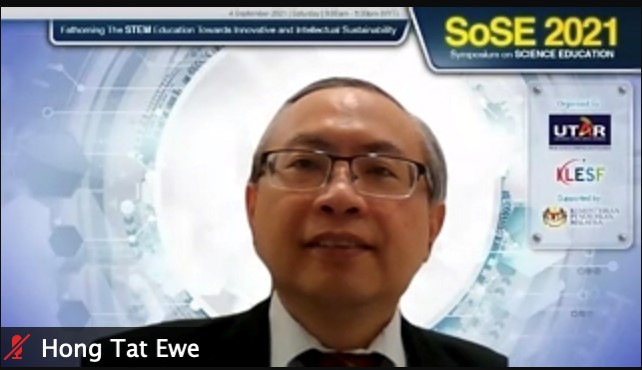
Prof Ewe highlighting the need for educators to maximise technologies for online teaching and learning
Present to officiate the opening of the virtual symposium was UTAR President Ir Prof Dr Ewe Hong Tat. “This symposium had welcomed participation from more than 200 educators who were from national, independent and international schools, as well as higher learning institutions from 2014 until 2019. However, in 2020, due to the Covid-19 outbreak, an inaugural Virtual Symposium was conducted for a week, delivering 10 mind-stimulating webinars that emphasised on the innovative methods of teaching strategies that will help every teacher in the classroom,” said Prof Ewe.
He added, “The Covid-19 pandemic has caused dramatic changes in people’s lives all over the world in many ways. Many educational, social and collaborative activities at national and international levels are being kept on hold. The discontinuation of face-to-face teaching has caused educational catastrophes in assessment strategies, learning styles and major interruptions in teaching across the globe. Educational institutions and educators all over the world are trying their best to respond with proactive measures while maintaining educational excellence. The integration of technology in teaching was once an option for many educators for various reasons. But, in the blink of an eye, a virus, which has become a deadly pandemic with tragic consequences, caused the educational shift to digital learning, and made teaching via digital tools possible for every educator. In fact, UNICEF emphasises that digital learning should become an essential service. This means connecting every child to world-class digital solutions that offer personalised learning to leapfrog to a brighter future. Now, teachers and lecturers across the globe are maximising technologies such as Microsoft Teams, Zoom and Google Meet that enable real-time, interactive and remote online teaching. As such, educators are constantly looking for new opportunities to enrich their digital knowledge to provide better learning experiences to their students. This demands for self-driven learning among the students. Students of all ages are now taking more initiative and autonomy for their own learning. They demonstrate increased metacognitive awareness in planning and evaluating their learning process.”
Also present were Co-Chairman of KLESF Steering Committee, President of Tunku Abdul Rahman University College (TAR UC) Prof Ir Dr Lee Sze Wei, UTAR Vice President for R&D and Commercialisation Prof Ts Dr Faidz bin Abd Rahman, UTAR Vice President for Student Development and Alumni Relations Prof Dr Choong Chee Keong, UTAR deans and directors.
Dr Ahmad Rafee describing the ministry’s initiatives in strengthening STEM education in the country
Delivering his keynote address, Dr Ahmad Rafee said, “Trends such as rapid organisation, demographic transition and technological breakthroughs contribute major changes to the world economic culture, as well as concepts, systems and organisations of the workforce in developed countries. In tackling these challenges, the world needs a new generation of talents who are able to adapt to the challenges of the future. The World Bank also places emphasis on STEM education, especially to ensure all women are involved. The STEM field is key to economic development and innovation. In order not to be left behind as a result of the rapid changes in the current social and economic landscape, the provision for an appropriate human capital development plan in the field of advanced technology must be carefully planned to meet the challenges of the future. Major countries of the world have created their respective STEM strategic plan.”
He continued, “Malaysia is expected to produce scientists, engineers, and technologists in the future. While the demand is growing in the STEM-related roles, the supply side is worrying as the number of students taking up STEM subjects has dropped from 48% in 2012 to 44% in 2020. In facing these challenges, the Ministry of Education Malaysia focused on getting teachers on board with the paradigm shift by launching a new STEM Teacher Competency Framework, which would shape how future STEM teachers are trained and assessed. Malaysia Education Blueprint (MEB) 2013-2025 has identified several factors that caused the decline of students’ enrolment in STEM. In the aspect of teachers, the quality of the teaching and learning process is less consistent, causing the teaching and learning process to be more teacher-centred and does not encourage students to think critically, creatively, and innovatively. In terms of parents’ awareness of the purpose of STEM learning and its relevance to daily life is still low, and even parents consider that the STEM field does not promise good job opportunities. This causes parents to encourage their children to choose literary streams rather than STEM stream.”
He also said, “In conjunction with strengthening the delivery of STEM across the education system, the Ministry of Education (MOE) Malaysia is implementing plans which focus on innovating to the next level. MOE will continue to collaborate with institutions, such as museums and centres to develop or skill up the learning process for students. These programmes may be built into the curriculum or delivered after school as an enrichment activity. Moreover, running a campaign to educate the public about the diversity of career opportunities in STEM-related fields to encourage more students to select STEM subjects is also a necessity. To address the issue of declining students’ interests in STEM, the ministry is also implementing a more structured and comprehensive STEM education initiative by linking various government and non-government agencies to ensure the country’s STEM education goal is achieved. This effort is also to ensure that the level of STEM proficiency among students can be improved, thereby providing sufficient manpower in the field of STEM, in line with the needs of the country in the future. The initiative’s main objective is to increase students’ interests, teachers’ skills, and public awareness.”
“STEM education aims to produce STEM literate students who are creative, innovative, inventive, and able to identify, apply, and integrate STEM concepts to understand problems and solve them. STEM students are proficient in applying the latest technology and can think logically and rationally, can design and create new products, and solve problems in daily life creatively and innovatively. Various activities have been implemented under the STEM education initiative since 2016, with the objective of increasing the awareness, interests, and achievements of students, teachers’ skills, as well as the awareness of parents and the public. Among the activities in the aspect of fostering awareness and interest of students are the school STEM carnival, the establishment of STEM clubs and the organisation of science week. The main efforts to improve teachers’ skills are through inquiry-based science education (IBSE) and inquiry-based mathematic education (IBME) programmes, which aim to help teachers implement teaching and learning by inquiry. Inquiry-based learning is a very effective method to ensure that students really understand what is learned, and not just memorising then rewrite. Through inquiry-based learning, students are encouraged to ask questions and find answers by conducting investigations and experiments, and hands-on activities. The ministry is also implementing strategic partnerships with various parties to ensure that more programmes can be implemented for the benefit of teachers and students throughout Malaysia. Among them are international parties, government agencies, private parties and non-government agencies,” enthused Dr Ahmad Rafee.
He concluded, “The theme of the symposium is very appropriate. This symposium emphasises on innovative teaching and learning methods. Through innovation, the younger generation can be transformed to be ready for the future. This is very important because the world in the future will be very different. Students need to be provided with analytical, creative, and innovative thinking skills so that they can face any challenges in the future.”
Clockwise from top left: Speakers of the symposium Prof Lim, Kho, Dr Chiam, Ku Haslizam, Sarimah and Dr Azmin
The highlight of the event was the sharing and presentations by the invited speakers, who were also winners of the Malaysia Toray Science Foundation (MTSF) Science Education Award, followed by lecturers / instructors / facilitators from Teacher’s Training Colleges / Universities and Excellent Teaching Award school teachers. The line of speakers consisted of Deputy Director-General of Education Malaysia (Teacher Professional Development Sector), Ministry of Education (MOE) Malaysia YBRS Dr Ahmad Rafee bin Che Kassim; 2020 MTSF (Malaysia Toray Science Foundation) Science & Technology Award recipient and UTAR Lee Kong Chian Faculty of Engineering and Science academic Prof Ir Dr Lim Yun Seng; TORAY award winner and Timbalan Pengerusi Majlis Guru Cemerlang (Bahagian Bintulu) of Sekolah Menengah Kebangsaan Bintulu, Sarawak Alan Kho Thong Phing; Pensyarah Cemerlang Gred Khas C (2020) award recipient Dr Chiam Sun May from Institut Pendidikan Guru Kampus Kent, Tuaran, Sabah; Silver Medalist in Kem pandang alam dalam kursus Pengenalan Sains Tauhidik, kNovasi UKM 2020 category and UKM Center for Teaching and Curriculum Development academic Assoc Prof Dr Azmin Sham Rambely; Guru Cemerlang DG48 2021 award recipient Sarimah binti Baharam from SK Setiawangsa, Kuala Lumpur; and Ikon Guru Cemerlang Akademik Menengah 2020 Peringkat Daerah award recipient Ku Haslizam bin Ku Azmi from SMK Permatang Bonglai, Kedah.
First to enlighten the participants was Prof Lim, who spoke on “Innovative controllers for energy storage as an all-round solution for energy trilemma”. He explained that the three essential areas of improvement in electricity supply are affordability, security and environmental sustainability. These three are also known as Energy Trilemma, as defined by World Energy Council. The new controllers for Energy Storage Systems (ESS) are used to deliver all-round solutions to the energy trilemma.
Prof Lim further explained, “The new controller of ESS reduces peak demand and improves the energy trilemma by enhancing the reliability of electricity supply through relief of generation and networks, in the security of supply aspect. For affordability, the new controller of ESS reduces maximum demand charge, reduces high generation cost, and defers new peaking plants and network upgrades. Meanwhile, in the environmental sustainability aspect, it minimises greenhouse gas emissions from peaking plants. In mitigating power quality issues, the new controller of ESS improves the energy trilemma by achieving 100% renewable energy, reduces carbon dioxide emissions by avoiding power plants for frequency control, improves the reliability of electricity supply, reduces electricity bills by solving voltage rise, avoids curtailment and improves the return of investments of solar farms, and prevents usage of expensive power plants for frequency control.”
He also mentioned that ESS possesses unique strengths. “It is transferrable because it can be changed to other functions and other locations. It is also scalable according to budget and space constraints; batteries can be reconditioned to give second life; and finally, it is robust as ESS is low in maintenance and resilient to faults,” explained Prof Lim.
Kho spoke on “Pembelajaran Berasaskan Projek Melahirkan Pelajar yang Kreatif dan Inovatif”, and said that education should be able to expand students’ potential and thereby enabling them to apply their skills and knowledge to benefit society.
“As a science teacher, my teachings aim to cultivate students’ interests and help them identify areas where they can apply their potential in Science. Some of the potentials found in these students are their abilities to think creatively and innovatively, lead, solve problems, and work together in a team. Therefore, STEM remains important because STEM jobs are the future of our economy; STEM teaches critical thinking and innovation, STEM classes provide unique opportunities for teamwork, STEM curriculum helps students develop project management skills, and recent events have only made technology skills more important than before,” explained Kho.
On increasing students’ interests in Science, Kho advised that learning should be impactful, for instance, project-based lessons which he found to be useful to teach students creativity. He also emphasised that students should be given opportunities to explore and solve problems in the context of science, and more importantly, the lessons should be fun and enjoyable. He then further shared his ideas for project-based lessons and the types of projects he used to teach his students.
Dr Chiam, on the other hand, spoke on “Inquire-Based Learning (IBL) in Science Education”. She explained, “Inquiry is the essence of science. Planning, specification and realisation of experiments are important parts of the process of acquiring key concepts. Inquiry also gives students the chance to learn, understand the process of producing scientific findings, and experience the nature of science. In IBL, acquiring new concepts and research methods goes hand in hand.”
According to Dr Chiam, IBL is beneficial to students as it nurtures students’ passion and talents; empowers students’ voice and honours students’ choice; increases motivation and engagement; fosters curiosity and a love for learning; teaches grit, perseverance, growth mindset and self-regulation; makes research meaningful; develops strong research skills; deepens understanding; fortifies the importance of asking good question; enables students to take ownership over their own learning and reach their goals; and lastly, gives them the ability to solve problems of tomorrow.
“Inquire -based Science Education (IBSE) takes a more student-centred approach to teaching and puts the focus on questions and problem-solving. Students learn through reasoning and doing, through asking questions, carrying out experiments, weighing up evidence, and considering alternative hypotheses. Students are also able to take charge of their learning from their own curiosity and the skills of scientific inquiry. The IBSE approach motivate learners to be interested in science and develops their scientific literacy and critical thinking skills,” explained Dr Chiam. She continued by explaining the science inquiry framework, levels of inquiry, and the various instructional models used in IBL. She concluded with some notes to emphasise that instruction should be student-centred; education should be collaborative; learning should have context; and lastly schools should be integrated with society.
Dr Azmin spoke on “STEM Teaching & Learning in New Normal”. She started by highlighting the importance of STEM education. She continued by explaining the STEM Integration Framework which is comprised of five key ideas, namely integration of the content of STEM disciplines; problem-solving learning; inquiry; design-based learning and cooperative work.
As she spoke on the plans and guidelines provided by UKM to assist lecturers in conducting online teaching and learning, she advised participants to walk through the course using notes, assignments, forums, activities, quizzes and assessments, as well as to increase students’ satisfaction by providing post-course syllabus, conducting surveys, being flexible, providing frequent interaction and increasing empathy towards students.
On conducting practical lessons online, Dr Azmin shared her experience while highlighting, “Firstly, plan your experiments, which include formulating your hypothesis, choosing your variables and your instruments. The second step is to make your measurements through many rounds of trials and errors, then make actual measurements and always record your final measurements. Next, is to process the measurements by plotting graphs and interpreting them, calculating and estimating uncertainties. Lastly, draw your conclusion by interpreting data using theory, evaluating the reliability of results, and stating your conclusions.” Before ending her sharing, she emphasised that teachers should teach students how to learn rather than what to learn.
In the session on “Kreativiti dalam PdPR (pengajaran dan pembelajaran di rumah) bagi Mata Pelajaran Matematik” by Sarimah, participants learnt that she used mastery learning, enquiry learning, project-based learning, and game-based learning to conduct her online classes. She also further explained that when conducting lessons, the techniques she used to enable her students to learn better were by providing explanation, in-class practical activities, enrichment activities, additional lessons, projects, and video recording, delivery of assignments, rewards, and lastly, managing online teaching and learning effectively. Sharing her experience, she further elucidated on the ways she used to manage online teaching and learning from home during the pandemic.
The final speaker of the symposium, Ku Haslizam, spoke on “Integrasi STEM dalam Matematik Ke Arah Pengajaran Abad ke-21” where he mentioned that education is likened to an orchestra, where players of various instruments come together to make beautiful music. He explained that education requires the same collaboration effort to make it effective and successful for students’ learning.
“The basic concept to implement an integrated STEM education is comprised of the 21st century learning using the 6C approach, 5E instructional model, and engineering design process. Applying these three concepts create a more integrated engineering design process, whereby various subjects can be integrated into learning. This will allow teachers across disciplines to collaborate and plan for students’ effective learning. Through this collaboration, lessons provided by the teachers would complement each other,” explained Ku Haslizam.
Participants also learnt that the 6C approach focuses on cultivating six important aspects of students’ skills, which are critical thinking, creativity, communication, collaboration, citizenship, and character. Meanwhile, the 5E instructional model emphasises on cultivating students’ ability to elaborate, engage, explore, explain and evaluate. In the engineering design process, participants understood this approach as a method to help students define a problem; imagine and plan; create; test; improve and share.
Before concluding his sharing, Ku Haslizam reemphasised the need for teachers to collaborate in making teaching and learning in STEM more effective. On ways for teachers to collaborate, he shared that they should take initiative to establish collaboration with other teachers from various disciplines; allow for continuous learning through various perspectives, ideas, and new knowledge; and lastly to keep an open mind to receive positive and negative feedback for continuous improvement.
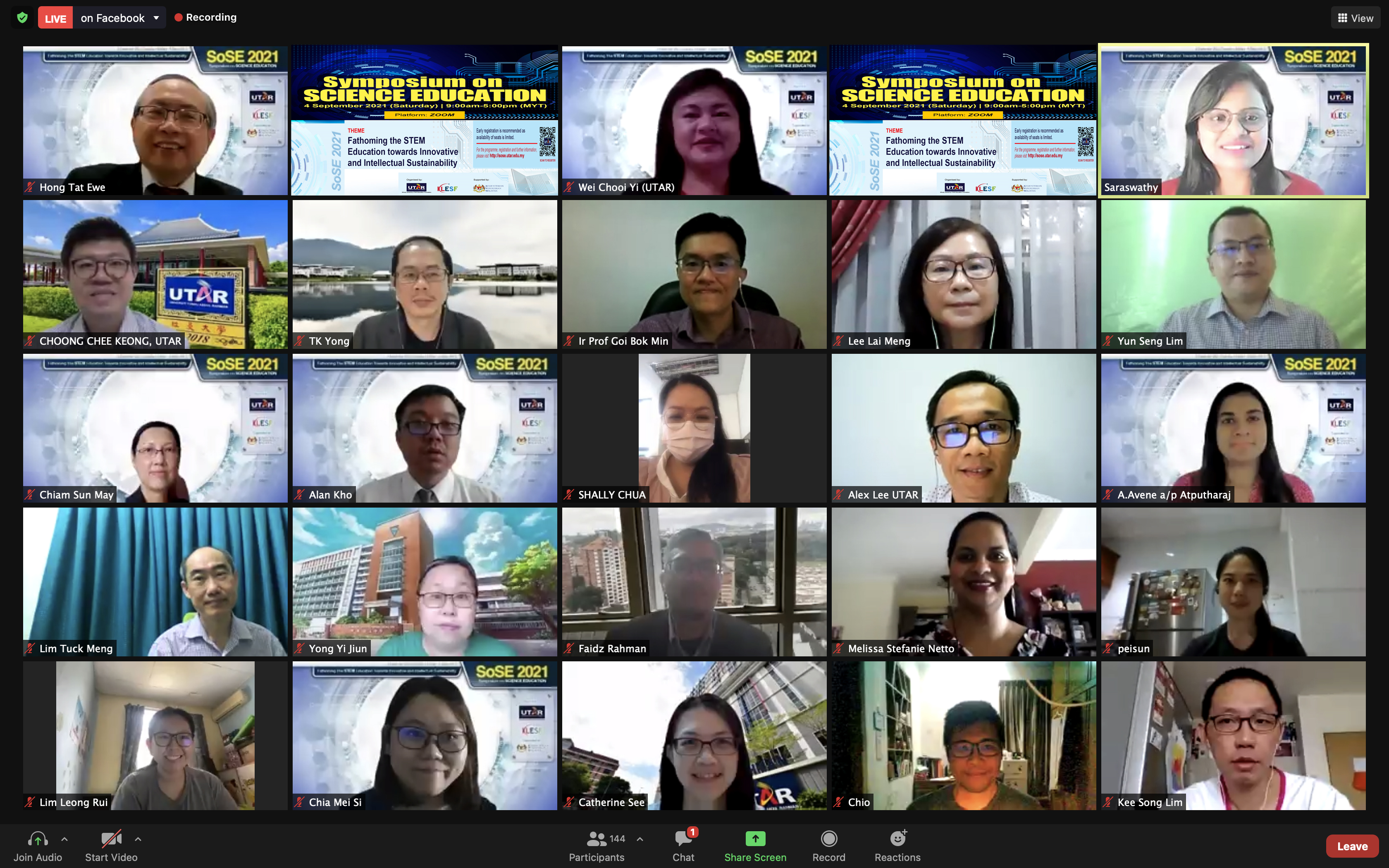
All smiles by the guests, speakers, and participants at SoSE 2021
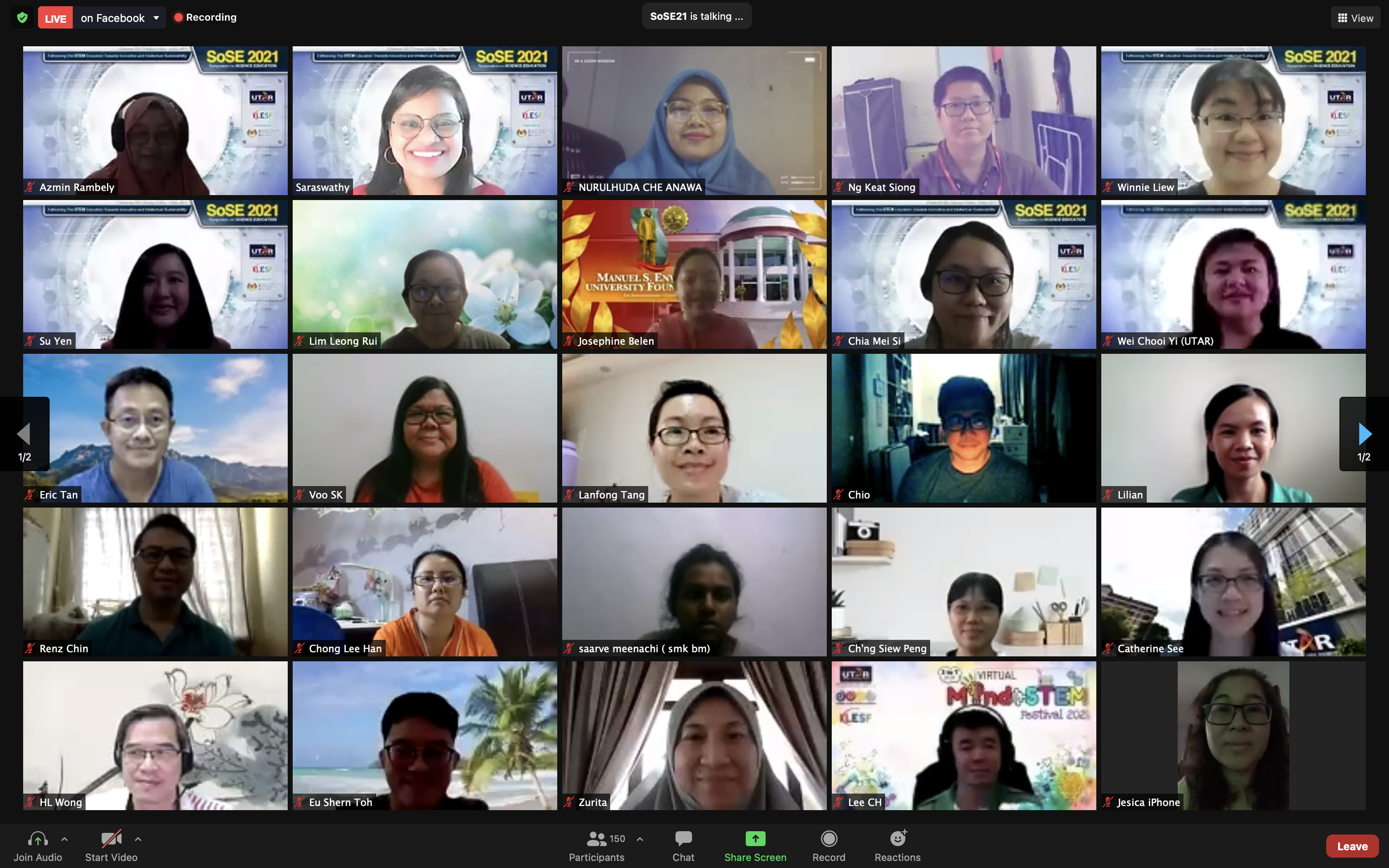
Some of the participants of the symposium
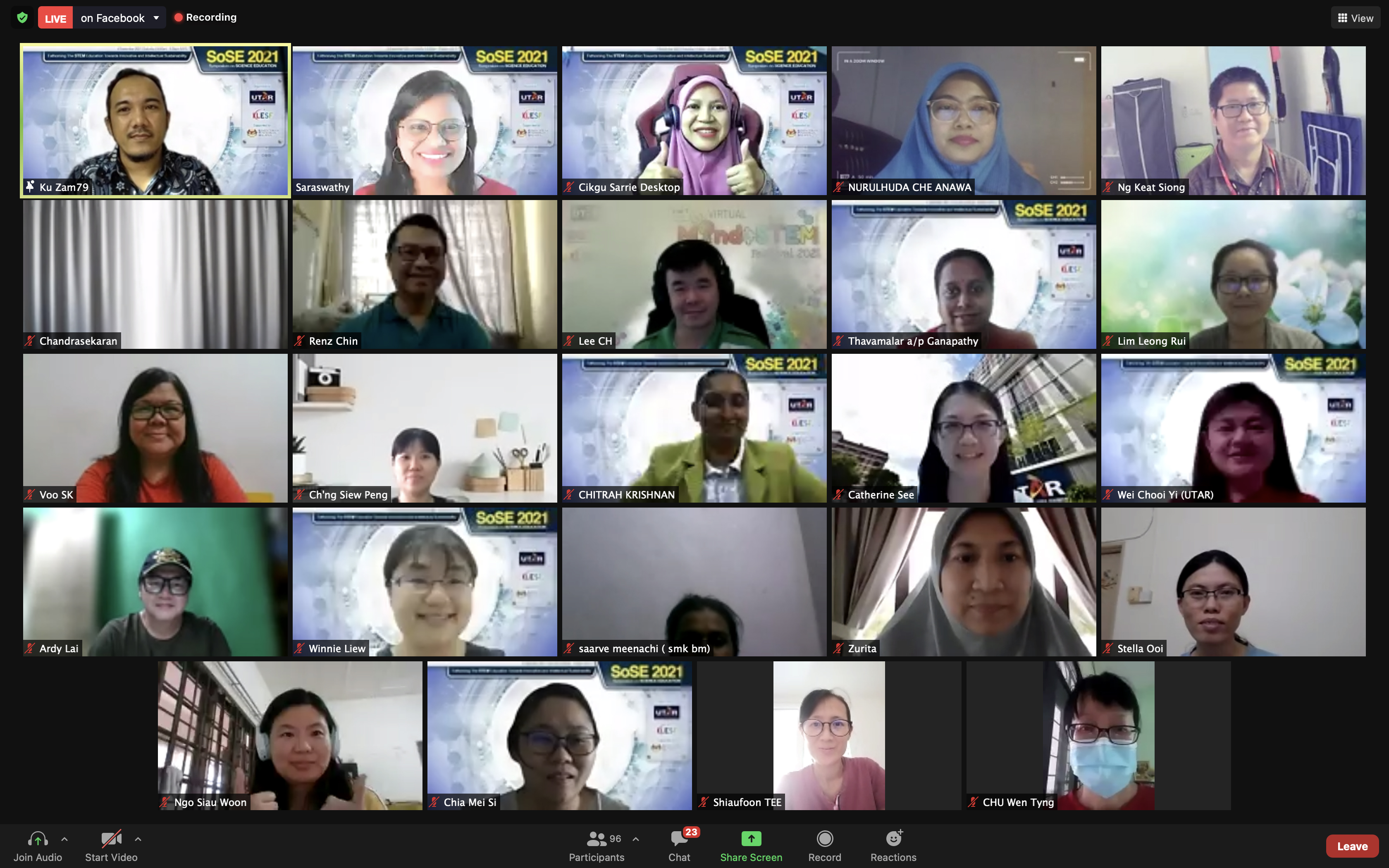
Another snapshot of speakers with some participants at the symposium
© 2021 UNIVERSITI TUNKU ABDUL RAHMAN DU012(A).
Wholly owned by UTAR Education Foundation (200201010564(578227-M)) LEGAL STATEMENT TERM OF USAGE PRIVACY NOTICE